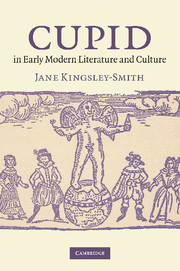Book contents
4 - Cupid and the boy – the pleasure and pain of boy-love
Published online by Cambridge University Press: 10 November 2010
Summary
On each side her
Stood pretty dimpled boys, like smiling Cupids,
With divers-coloured fans whose wind did seem
To glow the delicate cheeks which they did cool,
And what they undid did.
(Antony and Cleopatra, 2.2.208–12)Although Cupid's imposition of desire is often a means of asserting patriarchal authority over powerful and transgressive women, thus tacitly identifying him with the adult male, he was also an archetype for the beautiful boy in early modern culture. This rendered him an object of pleasure for both men and women, capable of arousing a remarkable range of desires while blurring the distinctions between them.
Immediately, we encounter the problem of setting an age on the early modern boy. This seems normally to have been between ten and eighteen, but he could be as young as three or as old as late-twenties, reflecting the use of ‘boy’ as a derogatory term, connoting social, moral or intellectual inferiority. Cupid's boyhood is further complicated by iconographic and literary traditions that fix him at different ages – in Ovid and Petrarch he is generally an adolescent; in Anacreontic poetry, a toddler or young child – and by early modern poets' vacillation between these traditions. For example, in Astrophil and Stella 73 ‘Love still a boy, and oft a wanton is’ (line 1), ‘wanton’ being used to describe the child's cruelty and rebelliousness whilst also carrying its adult meaning of ‘lascivious, unchaste, lewd’ (OED 1a, 4a, 2).
- Type
- Chapter
- Information
- Cupid in Early Modern Literature and Culture , pp. 133 - 162Publisher: Cambridge University PressPrint publication year: 2010



